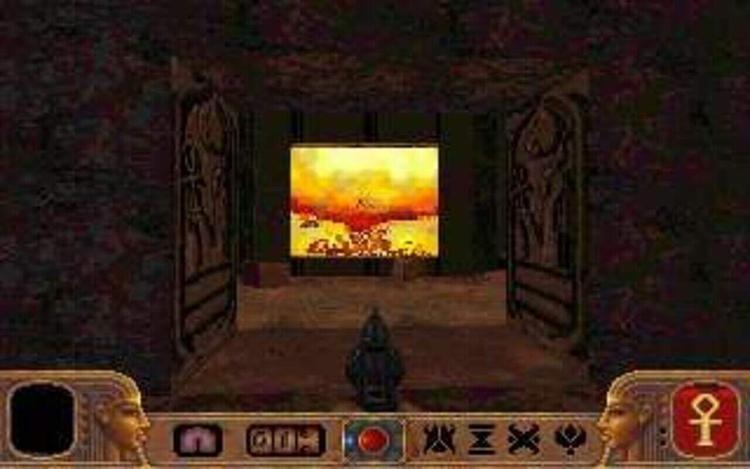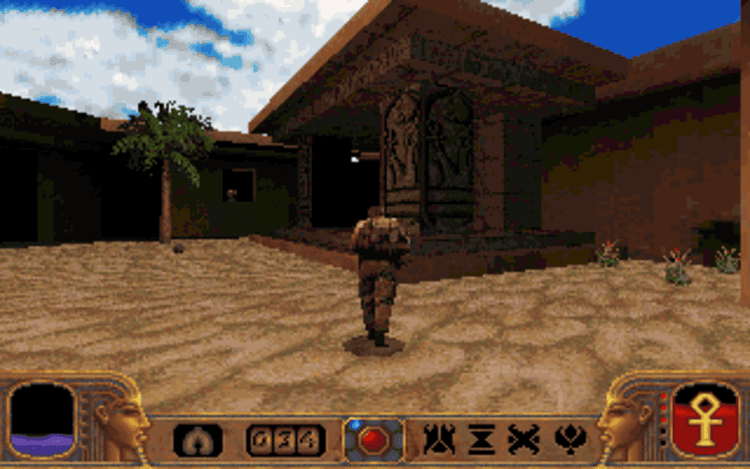
Released by Playmates Interactive, Powerslave is a myth-drenched first-person shooter that drops you into an atmospheric Egyptian necropolis crawling with alien forces. The game blends rapid-fire action with light exploration, letting you wield enchanted weapons and ancient artifacts against towering guardians. If you enjoy the frenetic pacing of Duke Nukem 3D or the mystical edge of Heretic, this adventure stands proudly beside them while forging its own identity. Smooth controls, clever level design, and a haunting soundtrack invite players to play the game online anytime, on any device, and lose themselves in its timeless thrills.
The mid-nineties marked a golden age for the first-person shooter, yet few titles dared to shift their battleground far from futuristic corridors. Powerslave, brought to life by Lobotomy Software and published by Playmates Interactive, broke from convention by plunging players into an Egyptian nightmare. From the opening temple courtyard shimmering in desert heat to subterranean catacombs echoing with distant chants, the game paints a vivid world ruled by Ramses and threatened by alien invaders. Every chamber feels handcrafted, inviting you to peer behind cracked sandstone walls for hidden urns and secret passages that reward curiosity with power-ups or new routes. The sense of place is so strong that even decades later it remains a benchmark for atmosphere, proving that pixel art and clever palette choices can summon more wonder than any modern shader-laden spectacle.
Powerslave’s Build-engine-inspired technology has been lovingly preserved in browser-friendly form, meaning you can play free within seconds—no downloads or installations, just pure action flowing directly through your web page. Thanks to efficient emulation layers, the game adapts smoothly to desktop monitors and mobile screens alike, preserving its fluid frame rate and responsive controls without restrictions. Touch overlays on phones map naturally to firing, jumping, and weapon cycling, while keyboards and gamepads on larger devices retain the classic feel. Whether you are reliving childhood memories on a laptop during a lunch break or discovering the adventure for the first time on a tablet from the couch, the experience remains faithful, immediate, and utterly transportable.
Powerslave distinguishes itself through a satisfying arsenal that marries ancient mysticism with sci-fi flair. Early on you grasp a machete and a trusty pistol, but the armory quickly expands to include the Cobra Staff that spits green energy bolts, the magical Mummies’ Ring whose ricocheting spheres curve through archways, and the devastating Eye of Ra that channels sunfire. Each weapon has situational advantages, encouraging experimentation rather than rote reliance on a single favorite. Levels complement this variety by looping back on themselves in Metroid-like fashion: unreachable ledges become accessible once you secure higher jump boots, underwater caverns reveal secrets after you discover the breathing mask, and previously sealed doors respond to artifacts gained in distant temples. This interconnectedness invites replay, transforming linear stages into sprawling sandboxes that reward mindful exploration.
At its core Powerslave is a test of skill and nerve. Enemies range from nimble Anubis warriors who flank with canine agility to hulking scorpion guardians whose stingers drip poison. Combat demands constant movement, strafe-dodging projectiles while gauging enemy patterns. Yet difficulty never feels unfair; generous hit feedback and clear audio cues telegraph threats, giving practiced players a chance to master each arena. Secrets tucked behind destructible walls or submerged beneath reflective pools grant extra health, ammo, and talismans that encourage thorough investigation. These design choices keep the game fresh even after multiple playthroughs, ensuring every return to Ramses’ realm reveals some new alcove or alternative strategy.
The visual direction further cements longevity. Despite the era’s technical limits, the engine delivers real-time lighting tricks, dappled water reflections, and towering architecture that dwarfs the player. Hieroglyph-etched corridors glow with braziers, while sandstorms swirl across open courtyards. Combined with an evocative soundtrack that blends tribal percussion with eerie synth pads, the result is a sensory tapestry that remains compelling long after polygon counts have multiplied elsewhere.
In modern hindsight Powerslave feels like the missing link between earlier corridor shooters and later adventure-driven FPS hybrids. Its willingness to introduce new movement abilities mid-campaign, encouraging backtracking and re-examination, foreshadowed mechanics that larger studios would popularize years later. Meanwhile its narrative—delivered through succinct monologues from the disembodied Pharaoh and environmental storytelling—shows restraint, trusting players to assemble lore from visual cues rather than lengthy exposition.
As for controls, the original scheme maps smoothly to today’s WASD or dual-stick layouts, and the game’s brisk responsiveness makes it ideal for speedruns. Yet newcomers can approach at their own pace, thanks to well-spaced checkpoints and intuitive enemy telegraphs. Even after countless sessions, landing a perfectly timed leap across crumbling platforms or dissolving a roomful of mummies with an explosive orb remains exhilarating.
Powerslave endures because it merges tight gunplay, atmospheric world-building, and thoughtfully layered level design into a cohesive adventure. It stands as proof that creative vision transcends hardware generations, offering players of any era a journey worth taking. A standard first-person control setup applies: move with directional keys or left stick, look around with mouse or right stick, fire with the primary action button, and switch weapons via number keys or shoulder buttons. Mastery lies in combining strafing, jumping, and artifact abilities to outmaneuver foes and uncover Ramses’ hidden treasures.
All codes used to run this title are publicly available, and the game remains the intellectual property of its original authors.
Share game
Share game








Share game